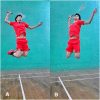Badminton Injuries in Elite Athletes: A Review of Epidemiology and Biomechanics
- PMID: 32399141
- PMCID: PMC7205924
- DOI: 10.1007/s43465-020-00054-1
Badminton Injuries in Elite Athletes: A Review of Epidemiology and Biomechanics
Abstract
Badminton is a popular sport in India and with multiple medal prospects will be closely followed at the Tokyo 2020 Olympics. Considered the fastest of the racquet sports, players require aerobic stamina, agility, strength, speed, and precision, besides requiring good motor coordination and complex racquet movements. Injuries in badminton are common despite it not being a contact sport, and include overuse injuries, and acute traumatic events. The game is physically challenging and demands complex repetitive upper and lower extremity movements with constant postural variations and poses a high risk of overuse injuries to both the appendicular and axial musculoskeletal systems. Badminton also necessitates short bursts of movement with sudden sharp changes in direction, which places players at risk of non-contact traumatic injuries to joints and muscle-tendon units. Preventing injuries and decreasing time away from training and competition are critical in an elite badminton player's sporting career. This analytical review identifies the incidence, severity, and profile of badminton injuries in elite players, and discusses the biomechanical basis of these injuries.
Keywords: Badminton; Biomechanics; Epidemiology; Injuries.
© Indian Orthopaedics Association 2020.
Conflict of interest statement
Conflict of interestThe authors declare that they have no conflict of interest.
Figures




References
-
- Badminton World Federation rankings; https://bwfbadminton.com/rankings/.
-
- Badminton Association of India; https://www.badmintonindia.org/.
-
- van Mechelen W, Hlobil H, Kemper HC. Incidence, severity, aetiology and prevention of sports injuries. A review of concepts. Sports Medicine. 1992;14(2):82–99. - PubMed
-
- Jorgensen U, Winge S. Epidemiology of badminton injuries. International Journal of Sports Medicine. 1987;8(6):379–382. - PubMed
Publication types
LinkOut - more resources
Full Text Sources
Medical
